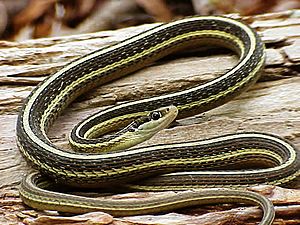Ribbon snake facts for kids
Quick facts for kids Ribbon snake |
|
|---|---|
 |
|
| Eastern ribbon snake (Thamnophis saurita saurita) | |
| Conservation status | |
| Scientific classification | |
| Genus: |
Thamnophis
|
| Species: |
saurita
|
| Subspecies | |
|
Four, see text |
|
| Synonyms | |
|
|
The ribbon snake (Thamnophis saurita) is a common type of garter snake found in Eastern North America. It is a non-venomous snake, meaning it is not harmful to humans. These snakes belong to a group called Colubridae.
Ribbon snakes usually grow to be about 16 to 35 inches (41 to 89 cm) long. They have a dark brown body with bright yellow stripes running along their sides and back. It's hard to tell male and female ribbon snakes apart just by looking at them, but females are often a bit thicker.
You can find ribbon snakes in wet places like creek beds, streams, lakes, and marshy areas. They are active from April to October. During the colder winter months, they go into hibernation to stay warm and safe. Ribbon snakes become adults and can start having babies when they are about 3 years old.
Contents
Types of Ribbon Snakes
There are four main types, or subspecies, of ribbon snakes. They are all a bit different depending on where they live:
- Eastern ribbon snake (T. s. saurita)
- This snake has a brown body with three clear stripes. These stripes are usually yellow. One stripe goes down its back, and one goes down each side.
- You can find this type from New York all the way down to Florida, and west to the Mississippi River.
- Northern ribbon snake (T. s. septentrionalis)
- This subspecies is dark brown or black. It has a yellow line down its back and often on its sides too.
- It lives in places like Maine, Ontario (Canada), and Indiana.
- Southern ribbon snake or peninsula ribbon snake (T. s. sackenii)
- This snake is usually tan or brown in color.
- Its home is from South Carolina south through Florida.
- Bluestripe ribbon snake (T. s. nitae)
- This type is dark with light blue stripes on its sides.
- It lives along the Gulf Coast in north-central Florida.
Where Ribbon Snakes Live
Ribbon snakes love places with lots of water and plants. They are often found near marshes, ponds, streams, and lakes. Since they hunt animals that are cold-blooded, they prefer living in areas with plenty of water. This makes it easier for them to swim and catch their food.
Even though they mostly live near water, you might also find them in forests or rocky areas that are a bit higher up. They need places where they can find both water and shelter.
What Ribbon Snakes Eat and Who Eats Them
Ribbon snakes are good hunters! They use their senses of hearing and sight to find food. Unlike some other snakes, ribbon snakes do not eat warm-blooded animals like mice or birds.
Their diet mainly includes:
- Newts
- Salamanders
- Frogs
- Toads
- Tadpoles
- Small fish
- Spiders
- Earthworms
Ribbon snakes can become food for other animals. Mammals like raccoons, birds of prey, and larger amphibians and reptiles might try to eat them.
When a ribbon snake feels threatened, it usually doesn't try to fight. Instead, it uses its brown body to blend in with the plants around it. They also try to escape quickly and hide in thick patches of grass. Once hidden, they will coil up and stay as close to the ground as possible to avoid being seen.
Smaller ribbon snakes have a challenge because they can only eat small prey. To help with this, these smaller snakes often have bigger heads compared to their body size. This allows them to eat slightly larger meals.
Life Cycle and Reproduction
After hibernating through the winter, ribbon snakes start looking for a mate in the spring. Ribbon snakes are special because they give birth to live young. This means the babies hatch inside the mother's body and are born alive, not in eggs laid outside.
Baby ribbon snakes are usually born in the summer. A mother snake can have anywhere from 4 to 27 babies in one group, called a litter.
Ribbon snakes become old enough to have their own babies when they are about 2 to 3 years old. Once they reach this age, they usually breed once or twice every year.


